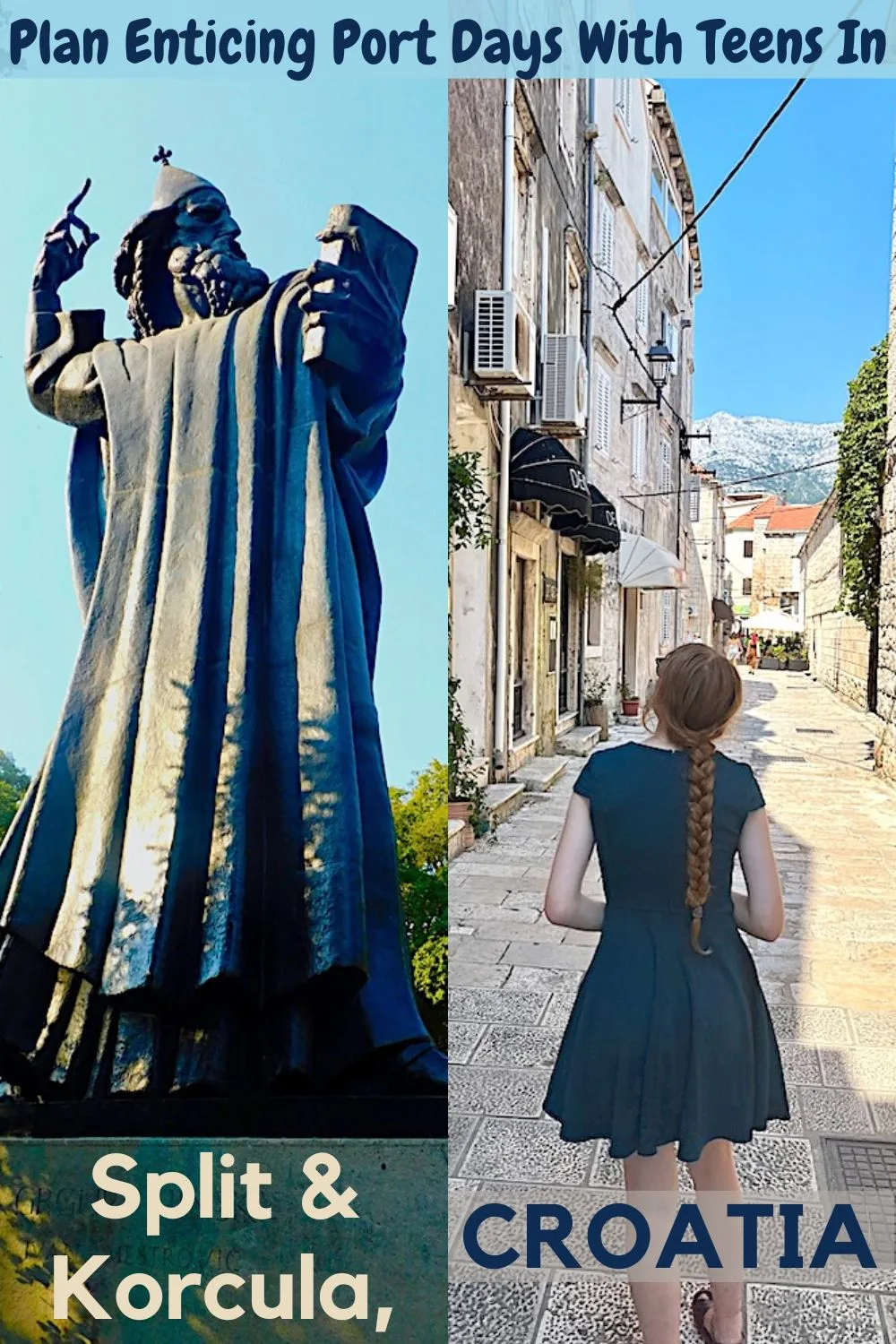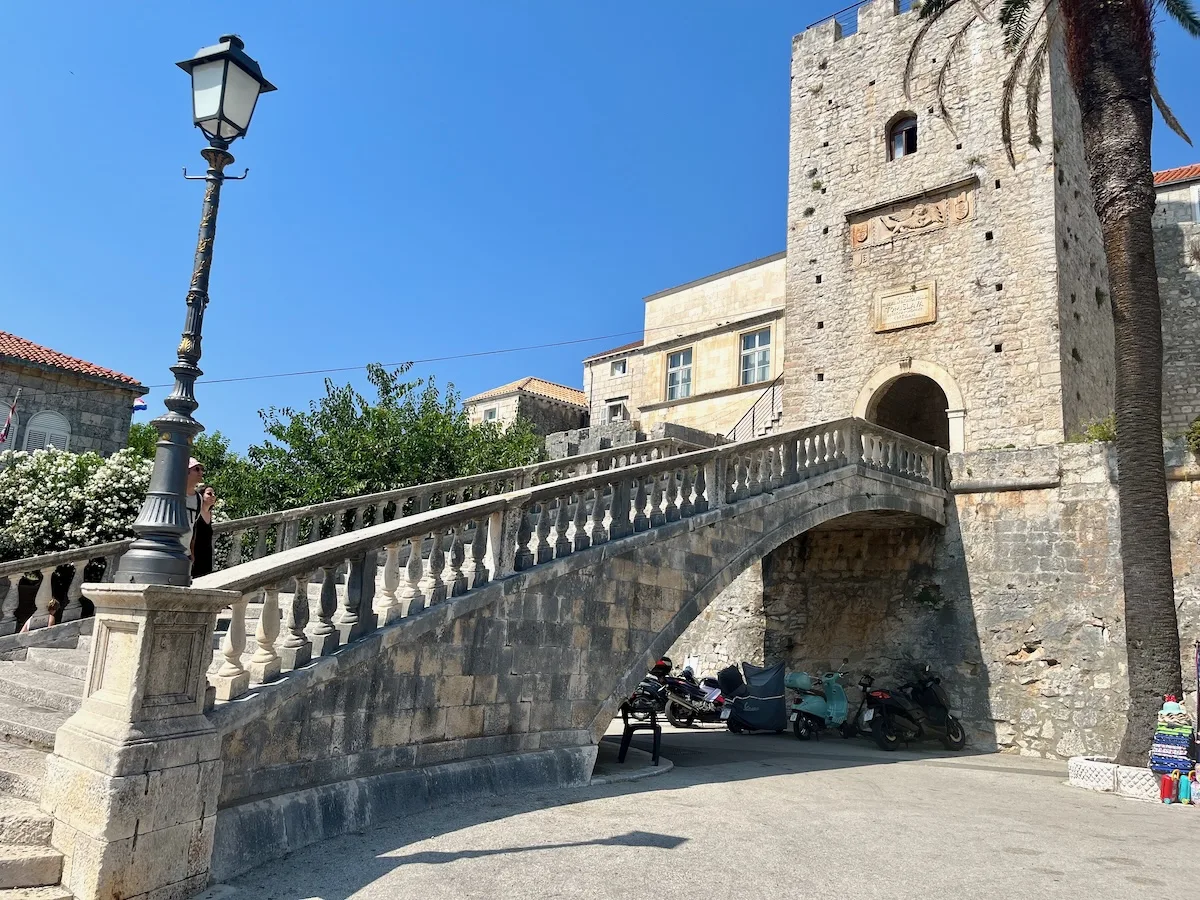One of the best things about taking a cruise is that there’s almost always one or two ports you know nothing about. These ports are often the places we like best and want to return to. On our recent Mediterranean cruise, the city of Split and the island of Korcula, both in Croatia, were our happy discoveries.
We knew Split was a city on the Dalmatian Coast with a lot of history, but that’s about it. And we’d never heard of Korcula, an island known among Europeans for its beaches, clear water and scenic old town.
Here is how we spent one day in each of these two scenic ports of call.
These were the first two stops on a Mediterranean cruise
• Read about our cruise experience on Holland America’s Oosterdam
• About our pre-cruise adventures in Venice
• About our next stops on the Greek islands of Santorini & Rhodes
• About our post-cruise visit to Athens
Scroll to the bottom for a Printable cruise vacation packing list
How To Make the Most of Your Mediterranean Cruise Stops in Split and Korcula
Split Cheat Sheet
• Getting to Port: Walk off the ship into town
• Must-See Attraction: Diocletian’s Palace and the Old Town
• Essential Local Shopping: The daily green market outside the Old Town
• Essential Stroll: Along the seaside promenade
• Essential Eating: Anything with seafood, on a patio with a view
A Busy Port Day in Split, Croatia
Split looks and feels like the seaside Mediterranean city it is. It has a long waterfront promenade that is the city’s front porch. It’s dotted with marinas, open-air cafés and bars with a backdrop of centuries-old buildings. We liked the city — or at least the small part of it that we saw — immediately.
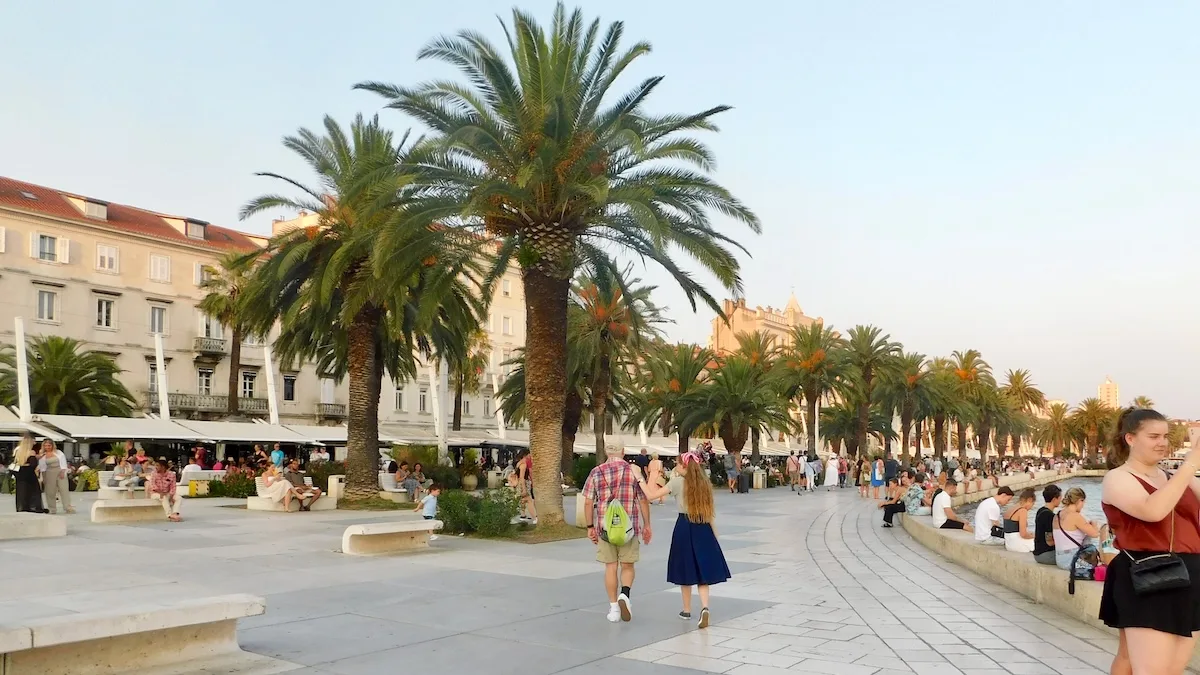
Essential Things to do in Split

• Diocletian’s Palace is a UNESCO world heritage site and the main attraction here. The palace and the old town around it have become woven together over time. You can’t readily tell where one ends and the other begins.
Interestingly, the old town is also a neighborhood where people live and work. So amid the throngs of tourists you can spot Splicani coming and going from apartments that often have very modern furnishings and laundry hanging between the ancient buildings.
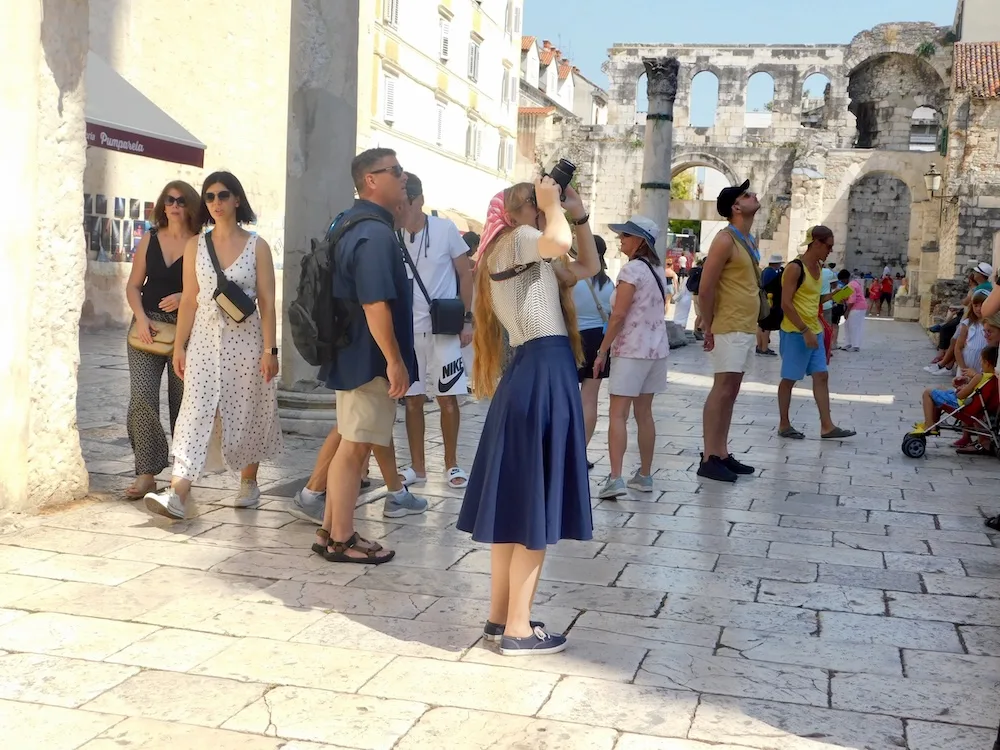
The town was built, built onto, filled in and built over as various native people and invaders swept in and out. You pass through several architectural periods as you go down to the lower parts of the palace. It’s hard to photograph the mish-mash of building styles, but they’re interesting to explore.
We booked a walking tour through Holland America and were glad we did. These rooms are a maze and there are no explanatory signs. Without a guide there would have been no way of knowing what we were looking at.
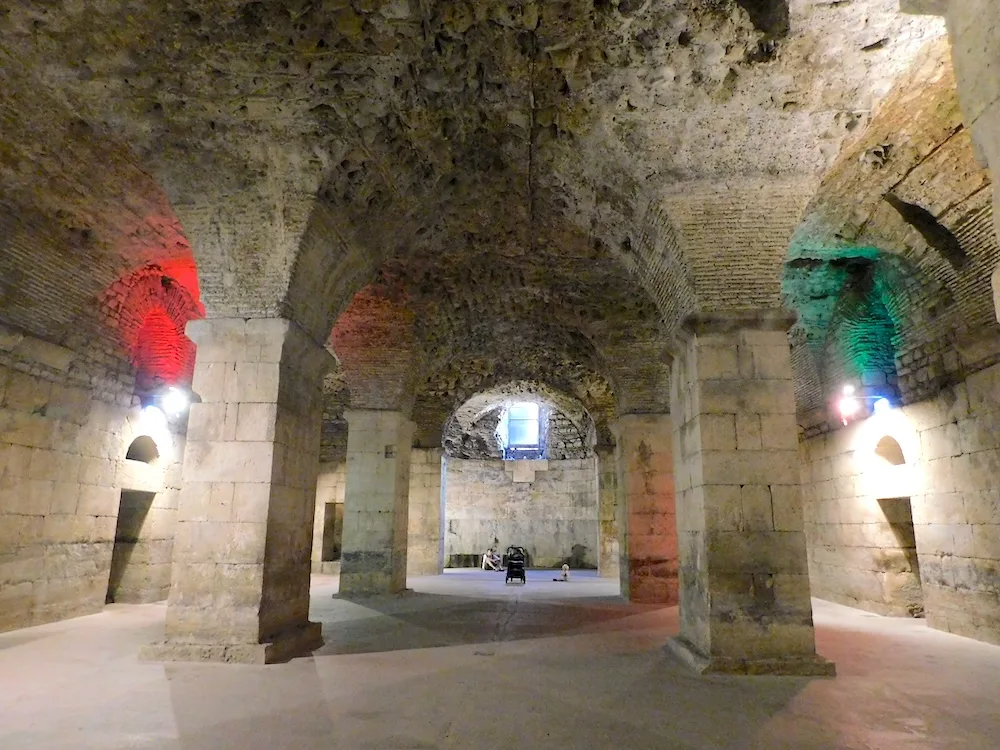
The Guided tours will take you through the palace “cellars”—the oldest part of the excavated palace — and some of the adjacent historic buildings including Jupiter’s Temple and St. Dominus Cathedral.
The Roman Emporer Diocletian was a notorious persecutor of Christians. When the Romans moved out, the local Christian communities that settled in were happy to build over his pagan structures with their own.
The cathedral was built on top of Diocletian’s mausoleum. You can see the ancient, medieval and baroque embellishments that were added over the centuries.
Jupiter’s temple was reinvented as a chapel dedicated to John the Baptist. You can still identify elements of both.
Tip: There’s a person standing outside the cathedral handing burlap shawls to people in whose shoulders or legs are too bare. They’re hot. I recommend packing a large, light scarf to cover up when you’re asked to for church visits throughout this region.
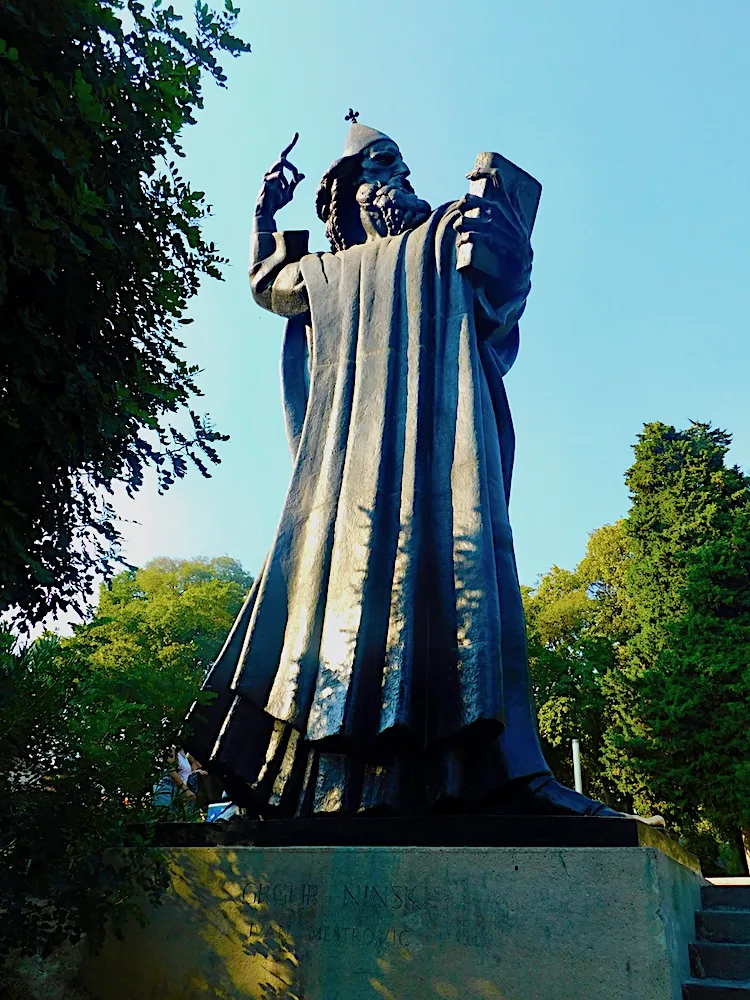

Make sure you exit through the Golden Gate at the back of the Old Town. Just beyond it there’s a giant statue of Gregor of Nin, a 10th Century bishop with some progressive ideas for his time. He looks a bit like Gandalf the Grey about to cast a spell on an army of trolls. It’s said that rubbing his left big toe brings luck and prosperity.

From Gregor we walked west down a street with hotels and restaurants that was a bit quieter than the Old Town. Then we turned into Republic Square, a large plaza with marble floors and salmon-pink 19th century buildings with arched arcades to shade the sidewalks.
There are cafés and bars on the plaza and tucked into some of the buildings. Some of these seemed especially popular with young people and were hopping.

From the square we headed uphill to explore Veli Varos, a former fishing village that’s been absorbed into the city. It has narrow streets and old stone houses with cafés and bars tucked in here and there.

From this neighborhood you can find the Marjan Hill stairs which take you up and up to a look-out point with a gorgeous bird’s eye view of the city and harbor. The walk is shaded but it’s something best tackled in the morning or late afternoon when it’s less hot. Have sun hats and water with you.

The stairs lead to Forest Park Marjan, a sprawling park with walking trails, more scenic vistas, an old cemetery, ruins, churches, a playground and more. There’s also a small Natural History Museum and Zoo. It’s not particularly impressive but a good option to know about if you have smaller kids with you.
• We walked through Varos and found our way to a set of shorter stairs back down to the street at the far end of the promenade. The stairs are next to a series of stone houses that are perched jauntily on top of some jagged cliffs and popular to photograph.
Shopping in Split’s Old Town
Part of the palace has become a bazaar with stands selling jewelry, soap and other souvenirs. There are shops throughout the Old Town, too. Most of the shopping is typical tourist souvenirs and quality varies quite a bit, but there are some unique items to be found.
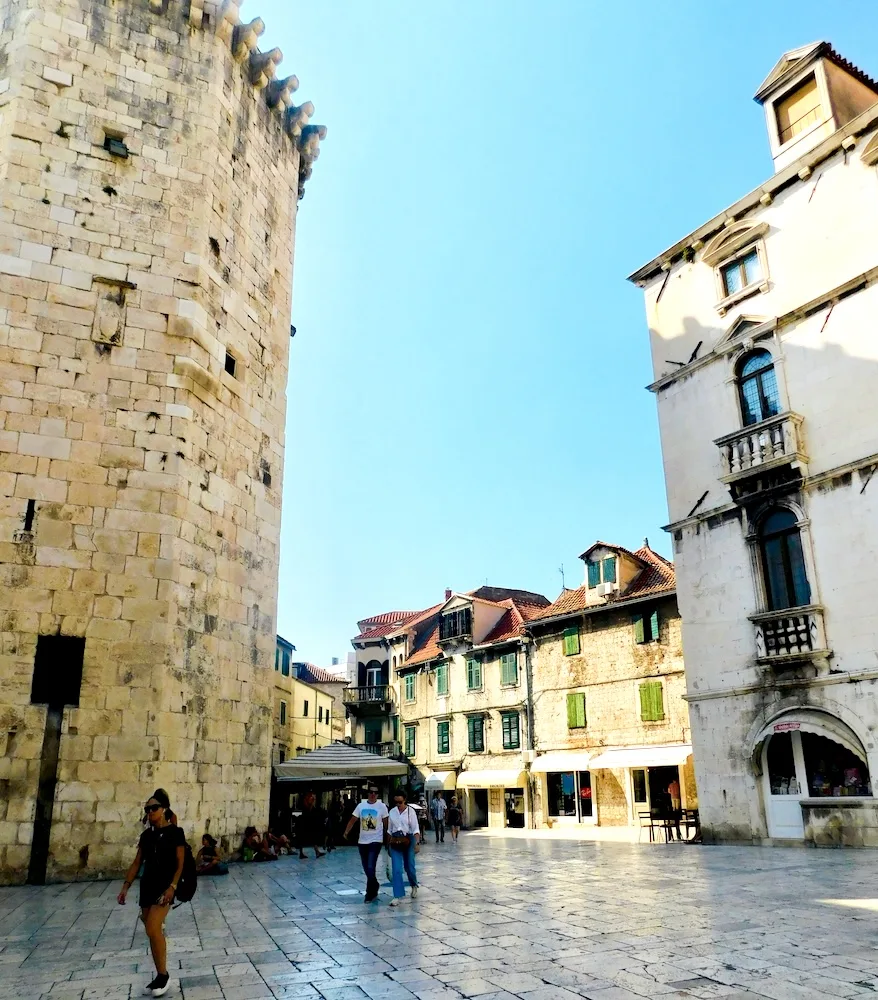
Our best find was Fjoret, a shop that made jewelry with tiny pressed flowers, a local tradition. Teen Traveler bought dangling earrings with red flowers that she’s worn a lot since we returned.
Where & What To Eat in Split

Varos has a smattering of seafood restaurants that can be a little expensive but are less crowded and more scenic than those in the Old Town. We settled on a place called Konoba Fratelli (Konoba is the word for tavern and denotes casual places to eat).
We sat on the terrace, which had a nice view of the promenade and good people-watching opportunities. The food was all made with care, delicious and reasonably priced. And the service was very friendly despite how busy it was.
Teen Traveler ordered grilled tuna with potatoes and string beans, which was a bigger dish than she expected. The waiter looked disappointed that she didn’t finish it and asked if there was anything wrong. We assured him she was just full.
Rich and both had risotto. Mine was flavored with saffron, shrimp and langoustines. His has shrimp and mussels in a red sauce. The seafood was fresh and the risotto creamy. Both went well with glasses of cold Croatian white wine.
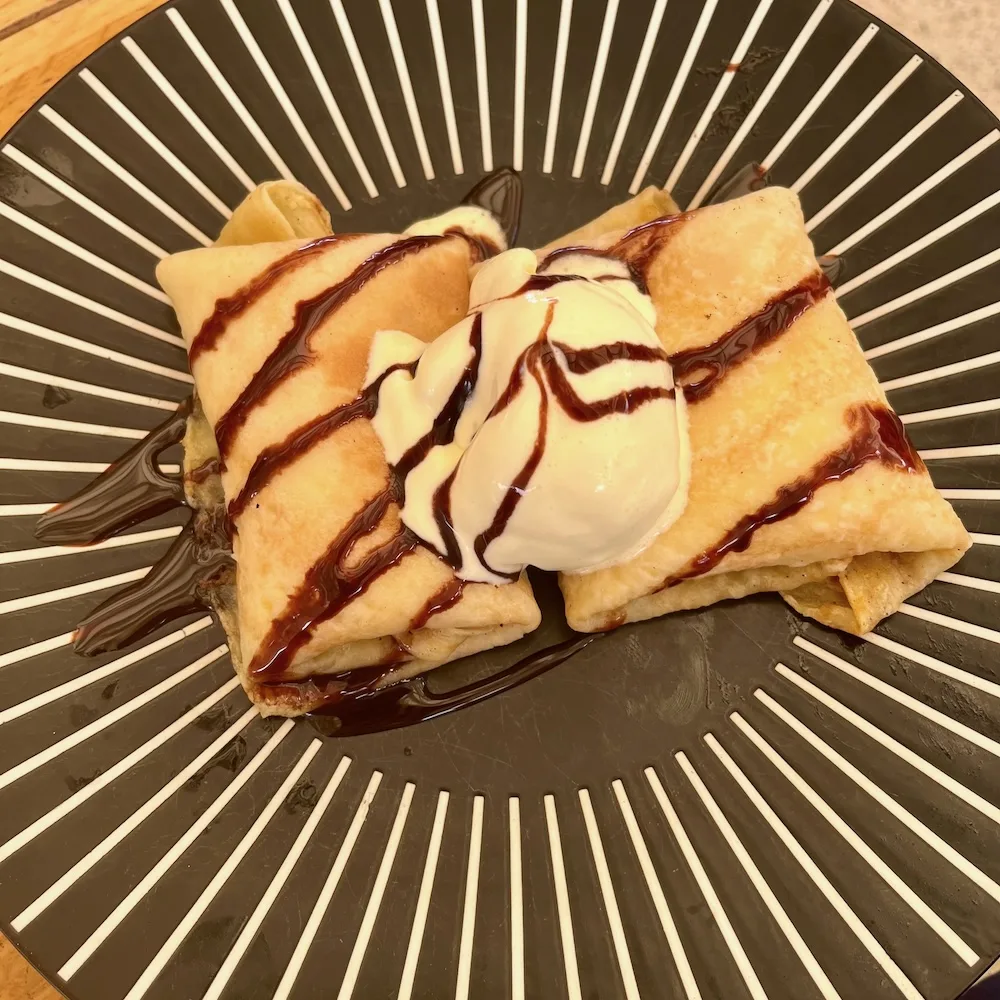

The sidewalk outside the old town, across from the water, is lined with shady outdoor cafés. We settled into one that had outdoor couches. Rich and I had glasses of summer-friendly local pilsner. Teen Traveler ordered palacinke, Croatian crêpes with vanilla ice cream. They disappeared before Rich or I had a chance to try it, so it must have been good.

We let our dinner digest and then bought gelato before heading back to the ship. We settled on aROMA Gelato, near one of the town entrances, because its flavors seemed complex and interesting rather than just overloaded and sweet.
Teen Traveler settled on dark chocolate. I chose mascarpone with pistachio and caramelized figs because it seemed to fit the place. They were thick enough to be ice cream and we headed back to the ship feeling that we’d chosen well.

There’s a daily farmer’s market alongside the walls of the old town on the side closest to the cruise-ship docks. In the warm weather it’s busier in the morning than in the late afternoon. You’ll find seasonal local produce that your cruise ship might not have. We bought a container of raspberries that we so sweet and juicy we stood under a tree and ate them on the spot. We bought fresh figs to take back to the ship.
Practical Information for Split
Cruises to Split are able to dock at a port right in town. It was an easy ten-minute walk from our Holland America ship to the palace. It’s very possible to explore on your own if that’s what you would like to do.
Some people took cabs or public transportation to the nearby beaches. Our port day was long enough that if we’d gotten an early start we could have added some beach time to our sightseeing. But we booked an afternoon tour and our teen (naturally) took advantage of this to sleep in.
A Relaxing Port Day in Korcula, Croatia
Korcula has deep blue water, gray cliffs, dark green pine forests and sand-colored stone houses with bright red roofs. The contrast in colors is fantastic when you see it from the water or from up above.
The forest and hills are in the middle and pocket beaches dot the outside. The beaches tend to be rocky, but the water is very clear. Its picturesque Old Town is another UNESCO site.
Korcula Cheat Sheet
• Getting to Port: Tenders to the dockside
• Can’t Miss Activity: Getting out on the water
• Essential Stroll: Through the Old Town
• Essential Dining: A glass of Croatian wine at a table by the water
Things to do on Korcula

If I were to go back, the ideal activity for me would be a few hours exploring the bay on a sailboat or motorboat, with a stop at a beach for swimming. I’d return in time to eat lunch and walk around the Old Town before returning to the ship.

We booked a kayaking expedition through the ship because it was a change from the sightseeing we were doing in most of the ports. Also, we like kayaking and we liked the prospect of being out on the water. It was a fine excursion, but it could have been better.
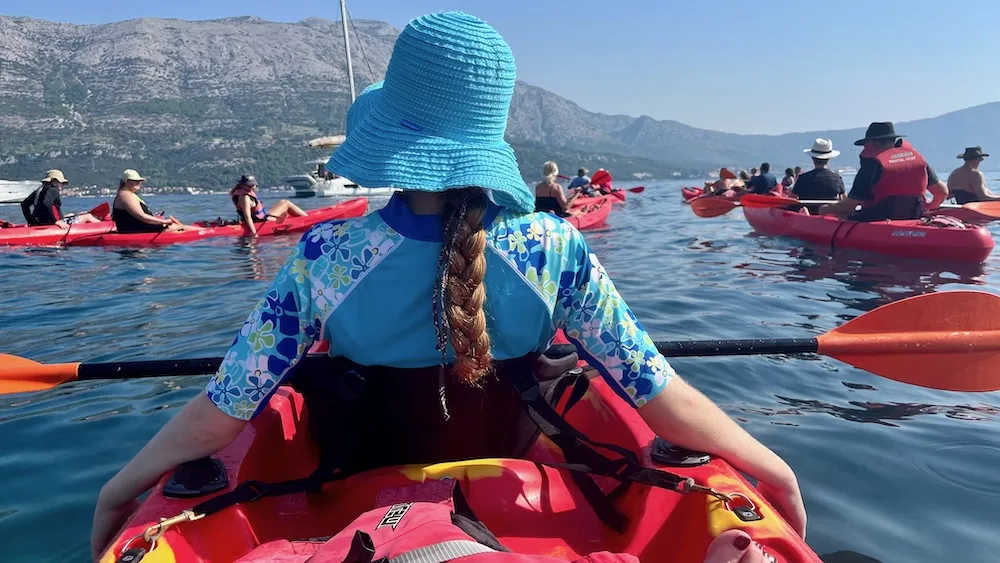
We were given sit-on-top kayaks, which are very stable but don’t have rudders. We were paddling through an open bay with currents and big boat wakes. Without a rudder it was hard to keep the kayak moving in a straight line. Constantly being pushed off course and having to correct made for slow-going and tired me out quickly, which made the excursion more work and less fun than it could have been.
Our destination was an island with a beach, an old monastery and friendly wild deer. Given the effort it took to get to the island, we would have liked to swim, walk around and explore the monastery, but didn’t have time to do it all.
We brought snorkel gear, so we opted for swimming. The water was clear and warm and the swimming was delightful. But there wasn’t much to see aside from a few small fish and some sea urchins (which we had to avoid stepping on). We gave up on the snorkeling pretty quickly and just enjoyed the swim.
On the return trip I found a strong paddler to partner with, which made the trip easier, and we had great views of the island and town from the water.
We arrived back feeling a little ambivalent about the experience. And very hungry.
Tip: If you choose this excursion, wear sunscreen and sunglasses, pack towels and hats and put your phone in a waterproof pouch.
You can leave a bag with dry clothes and shoes at the boathouse the kayaks launch from. But waterproof footwear is handy because you’ll want shoes on the island. Make sure everyone in the family has at least one strong paddler in each two-person kayak.

The boathouse for the kayaks had a small beach and a bar with light food and drinks. It would have been an easy place to chill out for the rest of the afternoon, but we chose to explore more.
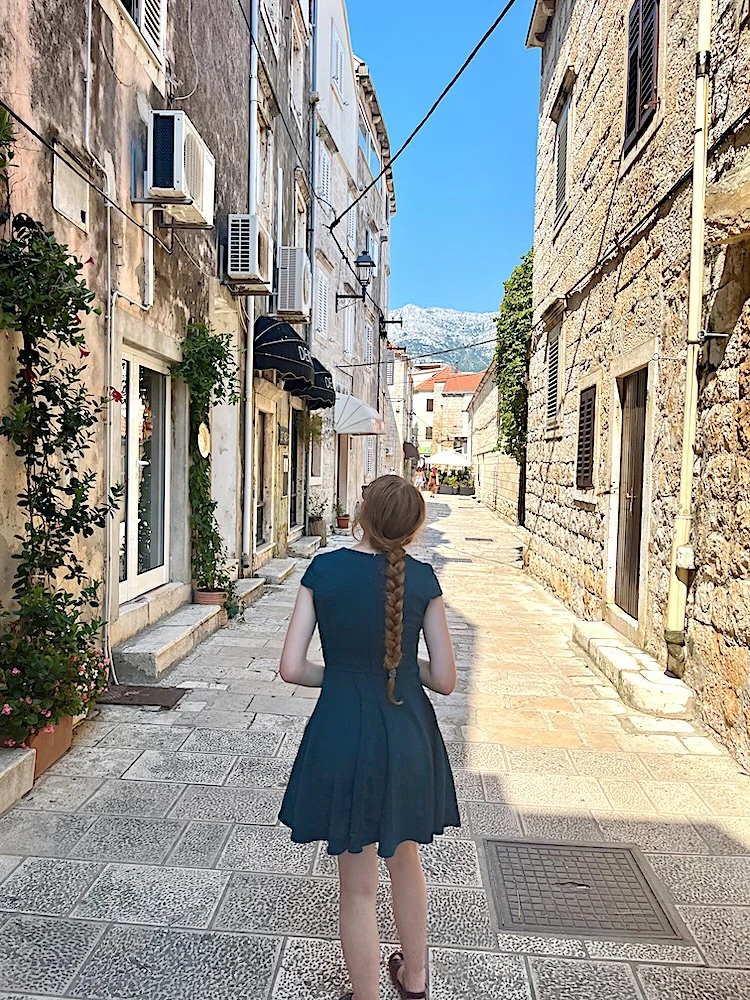

The “new” town is still pretty old and has its share of pretty al fresco restaurants. It was only after we climbed to the top of a hill and got above the town that we spotted the steeple of St. Mark’s church and realized we hadn’t actually gotten to the Old Town yet.
Luckily, the hill offered tremendous views of the town and water and was worth the climb.
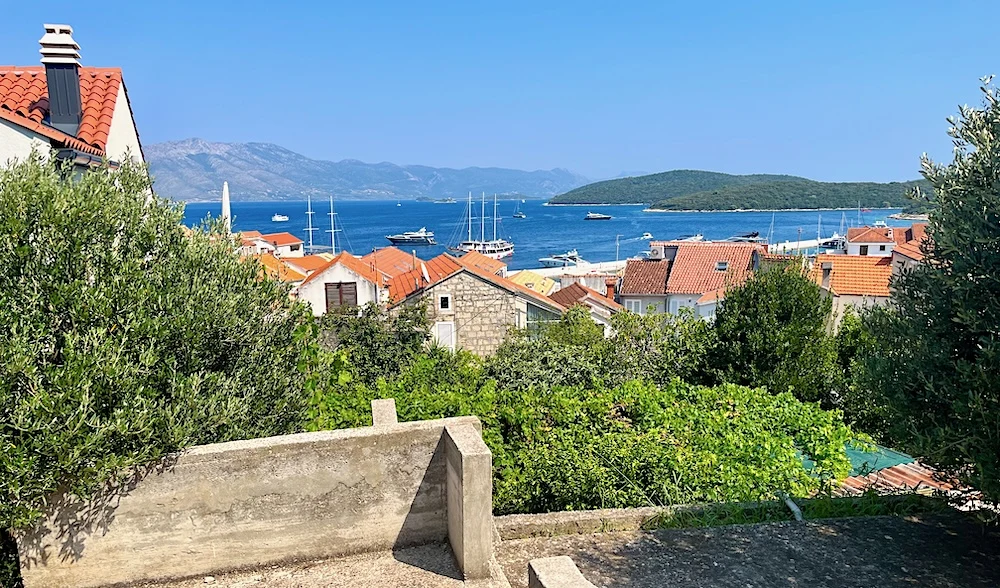

An elegant curved stone staircase that replaced a wooden drawbridge leads to the Old Town Gate (top).
Once inside the Old Town, you can visit St. Mark’s Cathedral, a 15th century church, and climb its bell tower for a small fee. If we hadn’t already climbed a hill with a gorgeous view we would have. But we were happy to enjoy the town from ground level.
Every alley and street seems to have a sea view at the end of it, which makes the town very photogenic. We spent a lot of time wandering the streets and taking photos.
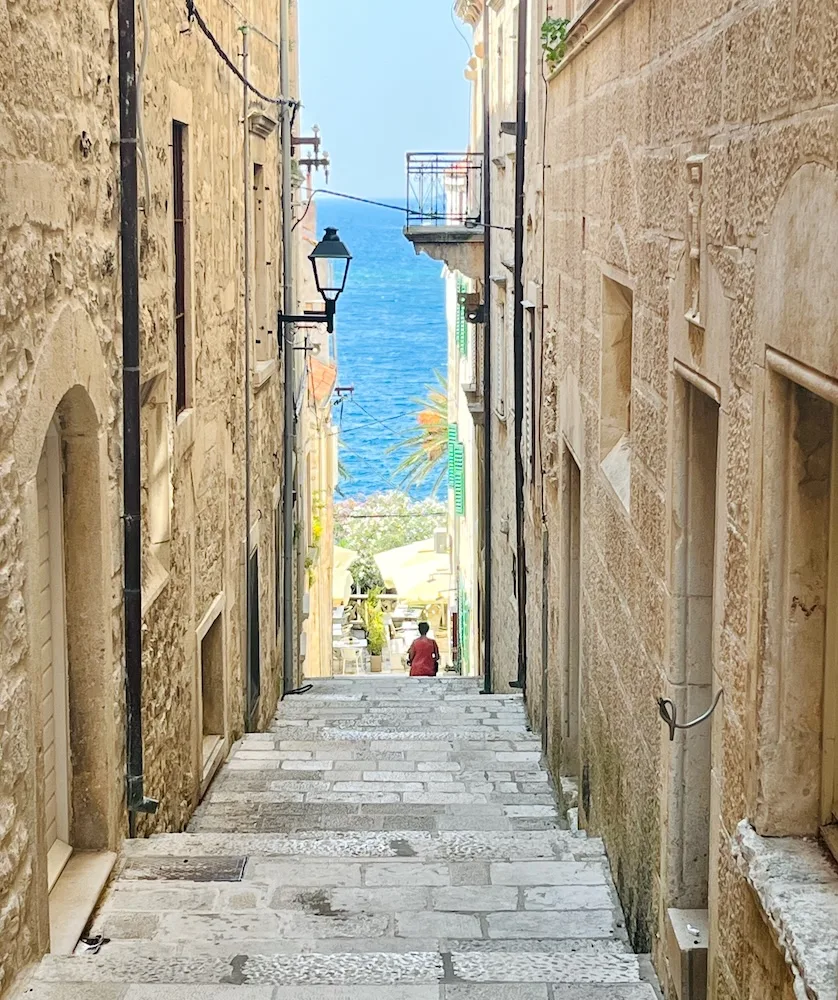
There’s a small town museum and the home where they say Marco Polo was born. There are also plenty of boutiques, jewelry shops and galleries. But none of these lured us in. I think the town was very scenic, and we wanted to enjoy it.
Where & what to eat on Korcula

The Old Town has restaurants with outdoor tables overlooking the water; they’re picturesque but also the most crowded and expensive options. The “new” town outside the city walls also has plenty of attractive restaurants with outdoor seating and gelaterias.
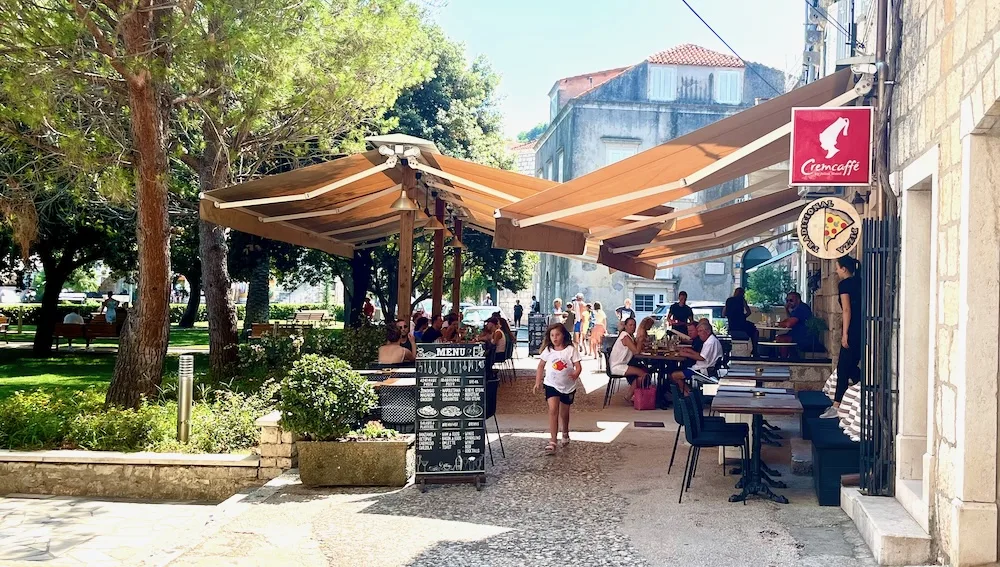

Walking from the boathouse back to town we found Servantes Food & Wine Bar with tables next to a shady pocket park. It was busy but not packed and everyone was eating pizza that looked great.
We ordered a small salad and two pizzas, one with dried sausage similar to pepperoni and one with thinly sliced zucchini. We tried some of the very dry local wine, too.
The thin-crust pizzas were heavy on oregano rather than the usual basil; it was surprising and excellent. The salad had greens, tomatoes, olives and cucumbers in olive oil without vinegar, which I liked.

Further down the street into town, Teen Traveler spotted a small ice cream shop that had soft-serve ice cream with interesting garnishes. She layered freeze-dried raspberries, vanilla ice cream and raspberry syrup. It was a far cry from the gourmet gelato we’d been eating, but she loved it.
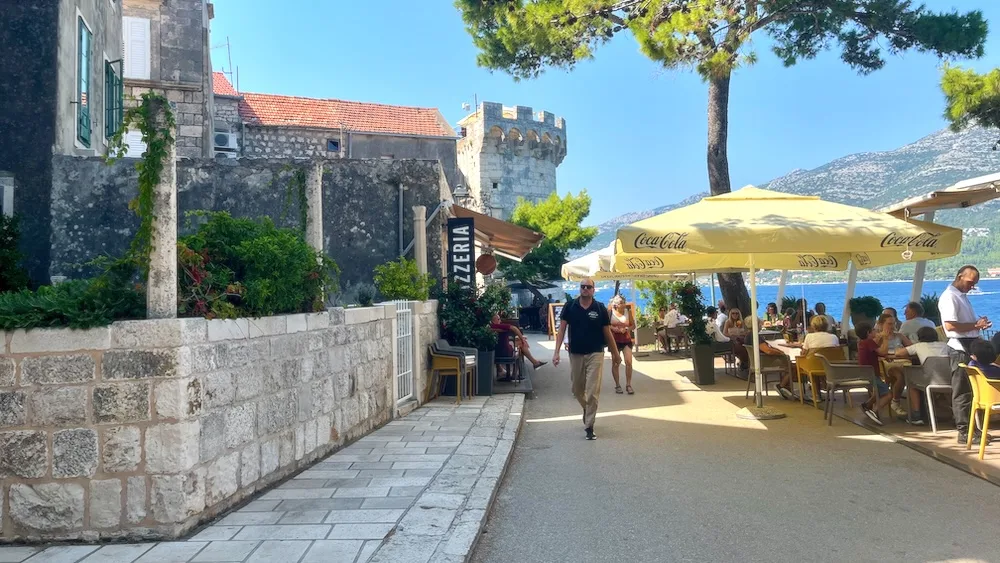

Even though we’d already had lunch, we wanted to enjoy the waterfront tables in the Old Town. After asking at a few places we found one that was OK with us just ordering drinks (most will only seat you to eat). We had a last beer and lemonade with scrubby cypress trees above us and blue water below before heading back to the ship, vowing to come back.
Practical Information for Korcula
• Pronunciation: The “c” in Korcula has a “ch” sound. And the emphasis is on the first syllable, like Portugal.
• People in Mediterranean countries take their “siesta” time seriously. Businesses not aimed at tourists, like grocery stores, drug stores and post offices, shut tight from 1:00 to 3:00 or even 4:00.
If you have practical errands to run onshore, do them in the morning or you might not find businesses open before you have to return to the ship.
• Cruise ships anchor off of Korcula and passengers take tenders to the docks. From here you can walk to anything you want to do in town, hire taxis or book shore excursions if you didn’t do so on the ship.
Pin it for later!
